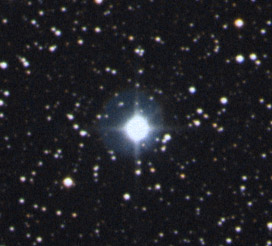| Planetary
Nebula
aka NGC 6572, PN G034.6+11.8, PK 034+11.1, ARO 7 RA: 18h12m05.0s Dec: +06°51'13" (Ophiuchus) Integrated Visual Magnitude: 9.0 Angular Diameter: 11" Mean Surface Brightness: 13.9 Mag/arc-sec² Distance 3500 ly Minimum requirements to detect: 4-inch scope under dark skies |
This is a small bright planetary nebula of high surface brightness. At low magnification it appears at first glance starlike, but its intense blue-green color should give it away. This planetary is a very good target for smaller scopes and high magnification. It boasts an integrated magnitude brighter than the famous Ring Nebula packed into a tiny 11" disk -- resulting in a surface brightness 100 times that of the Ring!
Of the color of NGC 6572 Walter Scott Houston wrote, "My old 10-inch reflector showed the vivid green color of the object with any power more than 50x. It is interesting to note that older observers have described NGC 6572 as green, while the younger ones tend to call it vivid blue." In my experience there as almost as many different perceptions of the color of planetary nebulae as there are people. Some see green, others see blue. Perhaps most see blue-green. A few see no color at all. In the case of NGC 6572 the color is so vivid that although there may be some question as to the shade very few will miss the color.
Many observers have reported seeing the central star as a slight brightening toward the center. Make sure and use as much magnification on this nebula as the conditions will permit.

The view in a 6-inch at 50x.
In May 2000 I observed NGC 6572 with my 18-inch Dob on an excellent night under dark skies:
I was stunned when I saw this one at 83x. In 25 years of observing with all manner of telescopes I had never seen blue in a planetary nebula. Now this marked the second time in less than a week that I had, and it was the most beautiful and obvious aquamarine I have ever seen in the night sky! At higher magnification there was some hint of structure to the outer edges of this round, high surface brightness object.
The above color image was created by combining red and blue second generation sky survey images. The high surface brightness of this nebula is apparent in the photograph, saturating the image to the point where little detail is visible. The field of view is 5' x 5', north is down and east is to the right.
| Millennium
Star Atlas Vol III Chart 1272
Sky Atlas 2000 Chart 15 Uranometria 2000 Vol I Chart 204 Herald-Bobroff Astroatlas B-05 C-39 |
